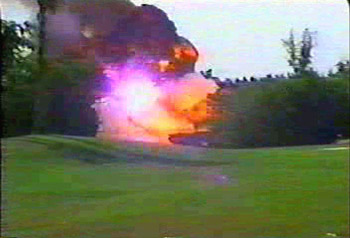

However, by this time, the overheated transformer's tank fails, and it dumps hundreds of gallons of flaming mineral oil onto the already devastated substation. Local firefighters can only watch from a distance since there's no way to safely fight this fire, and the substation is a total loss. As linemen often say, "Firemen don't mess with their wires, and linemen don't mess with their fires". A very sobering look at the explosive power lurking within that quietly humming substation in your neighborhood...
NOTE: Based on recent inputs from employees of Florida Power and Light (FPL), this event occurred at the Ives Dairy Substation located near San Simeon Way and Biscayne Boulevard in Miami, Florida. It is believed to have occurred in 2000 or 2001, and the footage was captured by a local resident from property that was adjacent to a country club and golf course. The root cause was a defective fuse holder associated with motor-operated high voltage switches. Substation switchgear was disabled when a small fuse blew, opening power to the motors on protective high voltage switches. Normally, the blown fuse would trigger an alarm to the dispatcher so that the problem could be promptly fixed. However, in this case, the defective fuse holder also prevented an alarm from being sent, so the power company was unaware that the substation was now unprotected.
Some time later, a low voltage side capacitor bank failed, creating an arcing fault that could no longer be cleared, since protection hardware was inoperable. The ongoing, undetected arcing fault ultimately led to the total destruction of the substation. Although at least one report indicated that the spray of white mist might have been water from a fire suppression system, it is now known that this particular substation did not employ an active fire suppression system, and the spray was, in fact, a "fog" of vaporized mineral oil. If you can provide more information about this event, please contact me.
The original source for this was Bert Hickman
who graciously said they can be used with permission.
Be sure to check out his awesome web site
at www.teslamania.com.